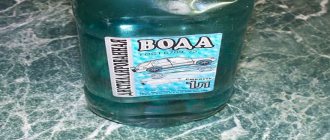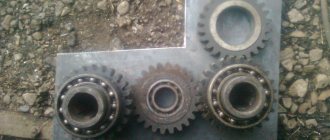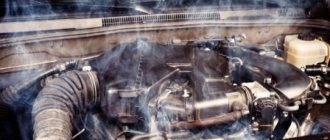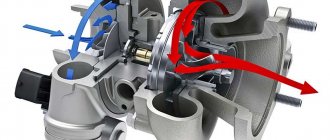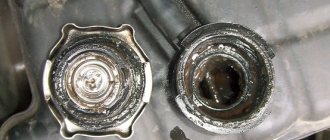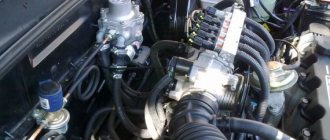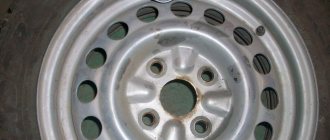Every year, car manufacturers introduce more and more advanced technologies into their models, equipping them with all kinds of electronic systems, including auxiliary and warning sensors. But, no matter how surprising automotive progress is today, there are phenomena that can harm a car, regardless of its technological filling. Among such phenomena is water in the gas tank. Someone, not always experienced, may probably think that water does not contain anything dangerous. However, this is a big misconception, because the consequences can be very serious, for everyone - both for the car and for the owner. What can happen if water gets into the gas tank? The consequences can have varying degrees of severity: from minor corrosion to failure of key components of the car.
For power plants operating on heavy fuel, the ingress of water can lead to a malfunction of the injection pump, or more precisely, the plunger pair. H2O, which seems harmless at first glance, can damage these elements of the fuel system within a very short time. If we talk about a gasoline engine, then the injectors or injection nozzle are in danger.
How does water get into the gas tank?
What is the danger of water in the gas tank, how can it get there?
Water, having a higher density than gasoline, sinks to the bottom of the gas tank and concentrates there. The fuel, being above it, prevents its evaporation and thereby simultaneously contributes to its accumulation. The following are the following undesirable processes in the fuel system of a car:
- Moisture provokes an oxidative reaction of the metals in it, which leads to their corrosion. The process of electrochemical corrosion, which is triggered by water absorbing sulfur compounds from low-quality fuel, is especially dangerous.
- In gasoline direct injection systems and diesel engines, moisture provokes a cavitation effect, leading to the destruction of the injectors.
- In winter, the presence of water in the fuel system, due to its ability to freeze and expand, can lead to failure of the fuel lines and is fraught with subsequent disassembly of the engine and replacement of components.
- In diesel engines, the presence of moisture leads to breakdown of the plunger pair and its expensive replacement.
The presence of moisture in the fuel tank can be determined by the following signs:
- difficult starting of a cold engine;
- uneven engine operation;
- strange sounds made by the engine, which are accompanied by its shaking;
- reduction in the dynamic characteristics of the car.
It is extremely easy for water to get into the fuel bank. This inevitably happens when refueling a car. Along with the pouring fuel, air with the moisture contained in it penetrates into the tank through the open hatch. There, water condensation forms on the walls, which flows into gasoline and sinks to the bottom. This occurs especially intensely in rainy or foggy weather.
During refueling, air and water vapor also enter the gas tank.
The culprits of moisture getting into the filling tank of a car are often small gas stations where there is an intensive circulation of fuel. Tanks are often emptied and filled, and water condensation collects in them, just like in fuel tankers. And although water does not dissolve in gasoline (and vice versa), with the active movement of these liquids and their mixing, an unstable emulsion is formed, which, when it gets into a car gas tank, again breaks down into gasoline and water. This is facilitated by the fact that the average passenger car spends 90% of its operating cycle at rest and only 10% in motion.
A significant contribution to the formation of moisture in the fuel system is made by the habit of many motorists to drive with half-empty tanks. They most often explain this by the desire to save on fuel by reducing the weight of the car. As a result, frequent refueling provokes a more intense flow of air into the gas tank. In addition, the less fuel it contains, the larger the area of contact of air with its walls and the more active the process of moisture condensation. Hence the recommendation of experts to keep the tank as full as possible, especially in wet weather.
Ways to fight
In total, there are several methods for effective water removal, which are divided into the following
- mechanical;
- chemical;
- using various additives.
Since each category includes several effective methods, they should be considered separately. And then everyone will decide for themselves what is better to use, and which method should be abandoned.
Mechanical removal
Some motorists use mechanical cleaning methods. Not the worst option, but inferior in speed to competitors. At this point, decide for yourself how ready you are to carry out such procedures.
- Dismantling. If there is a lot of water, and you are guaranteed to get rid of every last drop, plus clean the tank itself of accumulated sediment, you will have to remove the structure, remove all the contents and dry it. This method cannot be called a quick one;
- Communicating vessels. The point is this. You take a long hose, insert one end into the tank to the bottom, and the other into the prepared container. Moreover, the container must be placed so that it is lower than the level of the tank. It will be great if you have a pit, a lift or an overpass;
- Pump. And the fuel itself. In many cars it is located under the rear seats. You need to remove the supply hose from it, put the second one on the spool and place it in an empty container. The car ignition is turned on, and the pump responsible for pumping fuel begins pumping. The method is suitable only for injection engines.
Mechanical removal is quite effective, but very time-consuming. So this doesn't quite fit the topic of our conversation. We are looking for quick ways.
Chemical
Next comes the chemical method. It takes much less time, and you don’t have to disassemble or connect anything.
There are several options to choose from.
Binders. They bind water when they enter the fuel tank. It works effectively, but is considered a dangerous method. The water will remain inside, even if it changes its state of aggregation. The technique has not been well studied, so I don’t recommend taking risks; Machine oil. The method is suitable for a diesel car, where 50 liters of fuel requires 0.5 liters of oil. When water mixes with the lubricant, an emulsion will form and burn; Removal with acetone or alcohol. This is already for gasoline car engines. From 200 to 500 ml of product is poured into a full tank. The water will burn together with the resulting mixture
It is important to add it to a full gas tank. No harm to the car.
Here you only need to note that with the pressure of alcohol or acetone, all the sediment rises from the bottom. Therefore, after use, it is better to immediately change the filter in your fuel system.
Additives
A special moisture remover can be purchased at an automotive supply store. There are quite a lot of additives, and some of them do an excellent job.
They can be divided into 4 main ones
- Products designed to save fuel. They are poured into the tank, and about 10% savings in consumption are expected due to the fact that the engine is cleaned. At the same time, excess moisture is removed;
- Additives with a dehydrating effect. They are usually filled when the outside temperature is low and there is a risk of the fuel mixed with water in the tank freezing;
- Stabilizers. Additives with a stabilizing effect are already poured into the oil. Mainly affect exhaust, improve viscosity. Rather, to combat the consequences of water ingress;
- Restoring. They are also anti-friction additives. Remove accumulated dirt from internal surfaces, help improve compression and remove moisture.
Additives are a hot topic for motorists. Not everyone believes in their effectiveness and considers it right to pour foreign chemicals into their car.
How to detect water in a gas tank
For obvious reasons, the driver will not be able to look into the car’s gas tank and properly examine its contents. It is possible to understand that water has entered the tank only by a number of indirect signs.
You can see the water in the tank of a VAZ 2110 only by completely removing the tank
Main signs of water in the gas tank
We list the most common symptoms indicating moisture in the fuel tank of a car:
- the car won't start. This happens especially often in the morning, when the car owner tries to start an engine that has been sitting all night. During this time, moisture has time to penetrate the fuel line. From there it enters the fuel rail and injectors. Since the moisture sprayed by the injectors cannot ignite, starting the engine is impossible;
- engine malfunctions. The engine speed suddenly begins to “float”, and noticeable power drops periodically occur. This usually happens after pouring low-quality gasoline mixed with water;
- Gasoline leaks on the engine and under the car. Most often, this picture is observed at sub-zero temperatures. The reason is simple: moisture, having penetrated the car’s fuel line, freezes in it, and the resulting ice ruptures the pipes. Cracks form in the fuel line, through which gasoline leaks.
What are the reasons for water getting into fuel?
What causes moisture to get into the gas tank of vehicles? Is gasoline soluble in liquid? Usually water ends up in the gas tank when fuel is poured into it, namely through the neck hole. All other parts of the car fuel system are completely sealed.
The second reason for the appearance of moisture in the gas tank of a car can be called the formation of condensation, settling on the walls of the tank and subsequently flowing down to its bottom. This happens when the car is rarely refueled and is driven with a small amount of gasoline. Since water is much heavier in mass than the combustible mixture, it sinks to the bottom. Special suction devices are usually installed at the bottom of the gas tank, as a result of which the first start of the power unit is carried out on water with air. Because of this, the engine may not start immediately and may stall. After some time, the engine may gain speed.
The human factor plays a primary role in the problem, which is why water appears in gasoline. Water can be filled at a gas station, and the driver will not even suspect it. As a result, you get diluted low-quality gasoline, and your car suffers.
By trying to save money on refueling and buying cheaper, low-quality gasoline, you yourself can lead to the formation of moisture in your car’s gas tank.
Many unscrupulous sellers simply use water as a solvent, thereby intending to increase the number of fuel sales. This is how water begins to enter the gas tank of your car. Therefore, it is recommended to refuel only in places where you can be sure of the excellent quality of gasoline.
Water can also get into gasoline due to natural condensation. For example, this is often observed during the off-season. When you open the gas tank cap, you may see water droplets on the cap. This is condensation. Especially a lot of moisture accumulates at high air humidity. This way the tank gradually fills with water.
Another reason why water can get into the car tank is improper transportation or storage of fuel. In such situations, unscrupulous gas station owners who are not too concerned about the safety of their customers can again be blamed. Please note that it is also not recommended to refuel the car unnecessarily if it is foggy outside. This is again due to increased air humidity, which can cause water to enter the gas tank. If you need refueling, then in such weather you need to fill the tank completely.
Oddly enough, your ill-wishers may be pouring water into the tank. People are different, and sometimes, holding a grudge against you, they simply try to harm you by any means. There is only one way to combat this - put a lock on the gas tank cap.
What damage does water cause when it gets into the fuel tank of a car?
Many car owners are afraid of water getting into the fuel tank of their car, explaining their fears by the fact that this leads to expensive repairs. Whether this is true or not, let’s figure it out together, at the same time I’ll tell you which engines should really be “afraid” of water.
Where does water come from in a car's fuel tank?
- Water appears due to condensation formed during a sudden change in temperature. For example, when a car is placed in a warm garage in winter.
- When refueling at a gas station (in rare cases) or from a fuel can.
Conclusion
: Water is present in different quantities in every fuel tank of a car.
A small amount of water located at the bottom of the tank does not pose a danger, since the fuel receiver mesh will not allow it to penetrate the fuel system.
But if the amount of water at the fuel receiver exceeds the fuel, it will immediately enter the fuel pump. Having overcome the fuel pump, the water enters the fine filter, then the situation will repeat as with the fuel inlet mesh. If the amount of water in the filter exceeds the amount of fuel, the filter will not be able to contain the water. After the fine filter, the water flows straight to the engine.
What can happen if water gets into the engine?
Engines running on diesel
fuel
fail much more often than gasoline engines when water gets into the power system. This is due to the fact that when water gets into the injection pump (high pressure fuel pump), it fails, usually due to a breakdown in the plunger pair. As a result, expensive repairs are guaranteed.
Engines running on gasoline.
When water enters the engine through the fuel system, the engine begins to operate unstably, and in some cases even stops starting altogether. The solution to the problem is to clean the fuel system from water.
Freezing of water in the fine filter or on the fuel inlet mesh can lead to failure of the fuel pump.
Thank you for your attention! Refuel with high-quality fuel and change filters on time to avoid unexpected expensive repairs. Source
Source
Purpose and design of the fuel filter
To prevent excessive accumulation of water, the fuel filter is equipped with a separator. This device allows you to separate the liquid from the fuel and keep it at the bottom of the sump. It is necessary to drain the collected liquid in a timely manner, and such maintenance must be performed annually or after 30 thousand kilometers. The control system consists of a sensor and a signal diode that notifies about the occurrence of an emergency situation in the engine operation. A light and sound alarm notifies you of the need to drain the water to continue further movement of the vehicle.
This is interesting: Manual transmission, operating principle
The operating principle of the water alarm is quite simple. Such a device is a sealed flask with plates placed inside. A ring with magnets is placed on this structure and a change in the density of the liquid will cause it to float and trigger the sensor. To understand how such a system works, you should know that the density of water and fuel is significantly different. Depending on the car model, fuel filter problems are indicated by a light indicator or Check Engine icon.
Water in the gas tank
Using the example of the gas tank of a VAZ 21093 car, we will analyze the reasons for the appearance of water in the gas tank (fuel tank), the consequences of its presence there, as well as several ways to deal with this malfunction yourself.
Reasons for the appearance of water in a car's gas tank
Temperature changes
For example, it is cold at night, warm during the day. As a result, water condensation appears on the walls of the gas tank, formed from the air as it cools. If temperature changes are frequent, then quite a lot of water can accumulate in the fuel tank. Especially when constantly operating a car with an empty tank.
Water in fuel at a gas station
In various ways, water enters gasoline storage facilities at a gas station (gas station). Either they are rarely cleaned, or again there is condensation, or there is deliberate dilution.
Consequences of water in the gas tank
Water present in the fuel mixture impairs its combustion process. Hence the possible occurrence of some malfunctions related to engine operation:
— difficult starting;
— the engine “troits” at idle;
— “dips” and jerks when pressing the gas pedal.
To be fair, it should be noted that such problems are only possible if there is a sufficiently significant amount of water in the gas tank. In most cases, the fuel pickup of the fuel pump does not reach the “deposits” of water at the bottom of the fuel tank. Or it pumps a small amount into the engine fuel system, which is unable to affect its driving characteristics.
Therefore, if there is any of the listed malfunctions (or all of them), it is better to look for its cause in the carburetor systems, fuel filters of the power supply system, fuel pump, ignition system, etc., and leave checking for the presence of water in the gas tank for last.
How to remove water from a gas tank
In most cases, you need to accept the presence of water in the gas tank, since it does not have a significant effect on the operation of the engine. Water is always present there, since it is always in the air.
If there is a need to remove water from the gas tank, then there are several ways to deal with it.
Cleaning the fuel tank
This method allows you to radically, completely remove water from the gas tank. It is recommended to clean the fuel tank every two to three years. On the VAZ 21093 and similar cars, the fuel tank does not have a drain hole, so to clean it, you will have to remove it from the car and drain the water along with gasoline, and then dry it.
At the same time, you can remove internal deposits and dirt from the gas tank with a solvent. See “Cleaning the fuel tank on a VAZ 2108, 2109, 21099.”
As a less labor-intensive alternative, you can try cleaning the gas tank and removing water from it through the hole in it for the fuel pick-up. Access to it is through a hatch in the body under the rear seat.
Adding additives to gasoline
Currently, there are a sufficient number of gasoline additives (from different manufacturers) that bind and remove water. By periodically pouring them into the gas tank, you can remove a significant amount of water.
The use of acetone or alcohol as a substance that binds and removes water from a gas tank is not desirable, or possible, but rare. These substances have contraindications. With frequent use, alcohol increases corrosion of the metal elements of the fuel system, and acetone dissolves its plastic and rubber elements. And their one-time or rare use will not give the expected significant effect, since water enters the tank constantly.
Notes and additions
Since water is heavier than gasoline, when it enters the gas tank it sinks to the bottom and is located in the depressions of the stamping. When driving on an uneven road or a large volume of water in the tank, it is partially mixed with gasoline and drawn into the fuel line through the fuel intake.
It is partially removed on the way to the carburetor in a fine fuel filter with a paper filter element.
Therefore, it is important to monitor its condition and periodically replace it without waiting for its filter element to become clogged and subsequently reduce filtration efficiency
More articles on malfunctions of the fuel system of the engine of VAZ 2108, 2109, 21099 The fuel pump overheats, reasons If the fine filter is dirty, then most likely there will be clogging in other filters of the fuel system “Return” of the fuel system of VAZ 2108, 2109, 21099 Checking the fuel pump
The consequences of water for a car
Water flowing from the gas tank into the injector ramp cannot cause water hammer. Its presence in the mixture of air and gasoline even to some extent helps to clean the combustion chamber and piston bottoms from carbon deposits. However, water is harmful to the fuel system. The fuel pump breaks down, the injectors become clogged with mineral salts released from the water. The consequences of exposure to water are greatly manifested when the car is idle for a long time. The injector nozzles rust irreversibly and this problem can only be eliminated by replacing the injectors.
It is known that spare parts for car repairs are expensive, and if you do not take care of timely technical maintenance, then paying for troubleshooting is many times more expensive. For example, the Opel Astra (“Puki”) has not been used for three years. The long downtime resulted in the replacement of expensive injectors. To prevent an Opel gas tank, 1 bottle of water removal product costs 150 rubles is enough, and a set of injectors costs approximately 22,000 rubles.
How to remove water from a car's gas tank?
So, having understood in all details that water has no place in the engine, it’s time to think about how to deal with it. In fact, it's not difficult at all. And you don’t have to go to a car service center for this either. It is worth keeping in mind that water does not mix with gasoline at all. They remain separate factions; in a calm state, the water will be at the bottom and the fuel at the top. But water dissolves in any type of alcohol. They mix into a homogeneous liquid.
Armed with this knowledge, you can act in several ways:
- Take half a liter of alcohol and pour it into the gas tank. The result will be a mixture of alcohol and water, which will be almost identical in density to fuel. The water in the mixture will no longer freeze, and in the future it will simply pass into the engine and burn in the same way as gasoline. At the specified volume, adding alcohol will not affect the functioning of the motor.
- You can also get rid of water that has already settled a little and collected at the bottom of the fuel tank by draining it through the ramp. You just need to remove the spool and screw on the hose. When voltage is applied, the pump will start and discharge unnecessary fluid.
- It is possible to blow the liquid out through the tube. To do this, you need a thin hose, which is installed in place of the removed fuel pump, long enough to lower the second end lower in level.
However, that's not all. There are other solutions that can help deal with water. So, by going to any store that sells auto chemicals, you can find special preparations created specifically to solve this problem. However, many car enthusiasts prefer not to use them, believing that alcohols are more reliable and effective for such cases. Moreover, their price is lower.
It is worth noting that not only ethyl alcohol can be used. Isopropyl, which you can buy at a hardware store, for example, is also perfect. Pour from 0.2 to 0.5 liters into the gas tank; such a volume does not cause any harm.
It is worth eliminating the accumulation of water and improving the dynamics of the car in this way twice a year, before the start of the winter season and after it. Also, as part of a preventative measure, it is worth cleaning the injectors. Then the engine will definitely respond with gratitude and provide an easy start under any circumstances.
Tips for motorists: Where does the water in the gas tank come from, why is it dangerous and how to remove it?
Sometimes power is increased not for the sake of tuning, but for the sake of restoring factory characteristics. It so happens that a car engine tends to deteriorate its parameters due to many factors. One of these factors is the water in the gas tank. Experts talk about this.
Where does the water in the tank come from?
The reason for the appearance of liquid in the fuel system is not always low-quality gasoline or diesel fuel.
Water causes many problems, so it is important to carefully monitor the behavior of the car in order to notice condensation in time
You can determine the liquid in the tank by the following signs:
- In the morning the car is difficult to start, but the battery is fine. After refueling, gasoline rises to the top as it is lighter, and water accumulates at the bottom, from where it is taken into the fuel system.
- The engine is running rough, but the speed is set correctly, the cylinders are working, the spark plugs are in order. This happens when fuel is diluted with water.
The fuel tank can contain not only gasoline, but also moisture. It penetrates along with moist air every time the car is refueled in rainy or winter weather. As the steam settles on the walls of the tank, it condenses and flows into gasoline.
Since water and gasoline have different densities, the water is lower than the level of gasoline. Because of this, we do not notice its appearance there right away, and as it appears there, we will more and more often notice how the car begins to move with dips, jerks, loses momentum, and at one point simply stalls .
So where does the fluid in the gas tank come from?
- Gets in with low quality fuel.
- It is formed when moisture condenses in a leaking tank, especially in the off-season and in regions with a humid climate.
Why is water in gasoline dangerous?
Carburetor cars do not suffer from moisture, since the condensate drains easily. For injection and diesel cars, water is dangerous, especially in winter. When condensate freezes, the ice blocks the fuel line, causing the fuel pump to break down. The presence of water in the fuel leads to incorrect and difficult operation of the engine, jerking on the rise, and damage to the injector nozzles.
When the ice in the gas tank melts, the water can cause water hammer in the fuel system and damage the engine. Constant contact with condensate significantly accelerates the corrosion of metal parts.
How to remove water from a gas tank?
Prevention. In the fall, the tank is emptied and dried. After this, fuel is added until it is full. Use of auto chemicals. Special products bind water, but do not remove it from the fuel.
Automotive chemicals are used with caution, as their effect on the engine is unpredictable. Adding machine oil. The method is applicable for diesel cars
For 50 liters of fuel add 0.5 liters of oil. Grease with water forms an emulsion and burns. Adding medical alcohol. Pour a glass of clean liquid onto the entire fuel tank (for gasoline cars only). Alcohol mixes with water and burns without harming the engine. Please note that ethanol raises sediment from the bottom of the gas tank, so it is necessary to replace the fuel filter before filling. Alcohol is added in the fall before the first frost. Pumping out water. Remove the fuel pump and remove condensate through the tube. To do this, you can use a hose from a dropper.
If you find an error, please select a piece of text and press Ctrl+Enter.
Share
HOW TO DELETE
- Remove and clean the gas tank. The process is really labor-intensive, but it cannot be avoided if a large amount of water gets into the tank. If the engine periodically stalls, stalls, or does not start at all due to water getting into the tank, you will not be able to correct the situation otherwise. Once in the gas tank, water settles to the bottom without mixing with gasoline. In some types of construction, the manufacturer provides a drain hole. Therefore, to remove water from the gas tank, it is enough to place the car on a slight slope and unscrew the drain plug.
- Remove water using a fuel dryer. Additives of this kind are available in the line of technical fluids of the companies: Hi-Gear, Lavr, Liqui-Moly, etc. The peculiarity of fuel dryers is that they are able to remove only a small amount of water from the gas tank. To a greater extent, additives are intended for preventive use in order to combat condensation and moisture entering the fuel when storage and transportation rules are violated.
INFLUENCE ON THE ENGINE POWER SYSTEM
Getting into the cylinders, water lowers the combustion temperature and impairs the ignition of the air-fuel mixture. Therefore, the engine stalls and does not develop speed. The negative impact on batteries is the formation of corrosion. A large amount of water completely prevents the ignition of the fuel injection pump, so the engine simply will not start.
Unlike gasoline engines with distributor injection on valves, diesel engines also suffer from deterioration in the lubricity of the fuel. Due to water entering the high pressure circuit of a diesel engine and a gasoline engine with direct injection, cavitation processes occur. The collapse of cavitation bubbles negatively affects the injectors, thereby reducing the service life of the fuel equipment.
Water in the gas tank is especially dangerous in the winter. When freezing, it can block the coarse fuel filter, reduce the flow area of the fuel lines and block the fine filter.
Fuel dryers are used only for gasoline engines. To remove water from a diesel fuel tank, it will have to be removed and washed. Since the procedure is really labor-intensive, make sure that it is the water in the tank that caused the fuel system to malfunction. If problems arise in cold weather, try warming up the fuel filter and draining the sediment from it.
To prevent water from entering the injection pump, separators are installed on diesel engines. Water is removed from the sump either automatically or manually by the driver.
FUEL DRYERS
Installing a separator on a gasoline engine is impractical, so you can remove water from the gas tank using special additives. Since water is dense, it accumulates and settles at the bottom of the tank. Dryers are not able to miraculously remove water from the gas tank; they only allow it to mix with gasoline and naturally exit into the exhaust pipe during the exhaust stroke.
The capacity of one bottle of fuel desiccant is calculated by the manufacturer based on the average volume of a full tank (50-60 l). But this calculation is based on the amount of moisture that enters the gas tank with an average volume for passenger cars during normal operation of the car. Another difficulty is that the additive must mix well with both gasoline and water. Under experimental conditions, it is possible to thoroughly shake a test tube with gasoline, desiccant and water. But it is difficult to imagine what kind of seismic activity there must be in order for the water settled at the bottom of the gas tank to mix well with the additive.
An important characteristic of dehumidifiers is the presence of anti-corrosion additives. Therefore, we do not recommend trying to remove water from the gas tank using household alcohol or acetone
HOW OFTEN TO USE
In the wet season, the manufacturer of the formulations advises adding an additive every 3-5 fill-ups. To prevent water from getting into the gas tank, we recommend not refueling in questionable places. In the winter and autumn seasons, to prevent condensation from accumulating, try to keep as much fuel as possible in the tank.
Prevention
In conclusion, a few simple rules, following which will help prevent the accumulation of water in the gas tank, or minimize this process:
- Keep the fuel level in the gas tank high.
- Use appropriate fuel additives periodically.
- Try not to refuel at unverified gas stations.
- Avoid gas stations with inappropriately attractive fuel prices.
- Protect the gas tank filler neck from evil neighbors, children and hooligans, if this is not originally provided for on your car.
As a rule, if you refuel to full and visit proven gas stations without waiting for the light on the dashboard to light up, you can avoid water in the gas tank. And using a good additive just once a year, you can completely forget about the problem forever.

